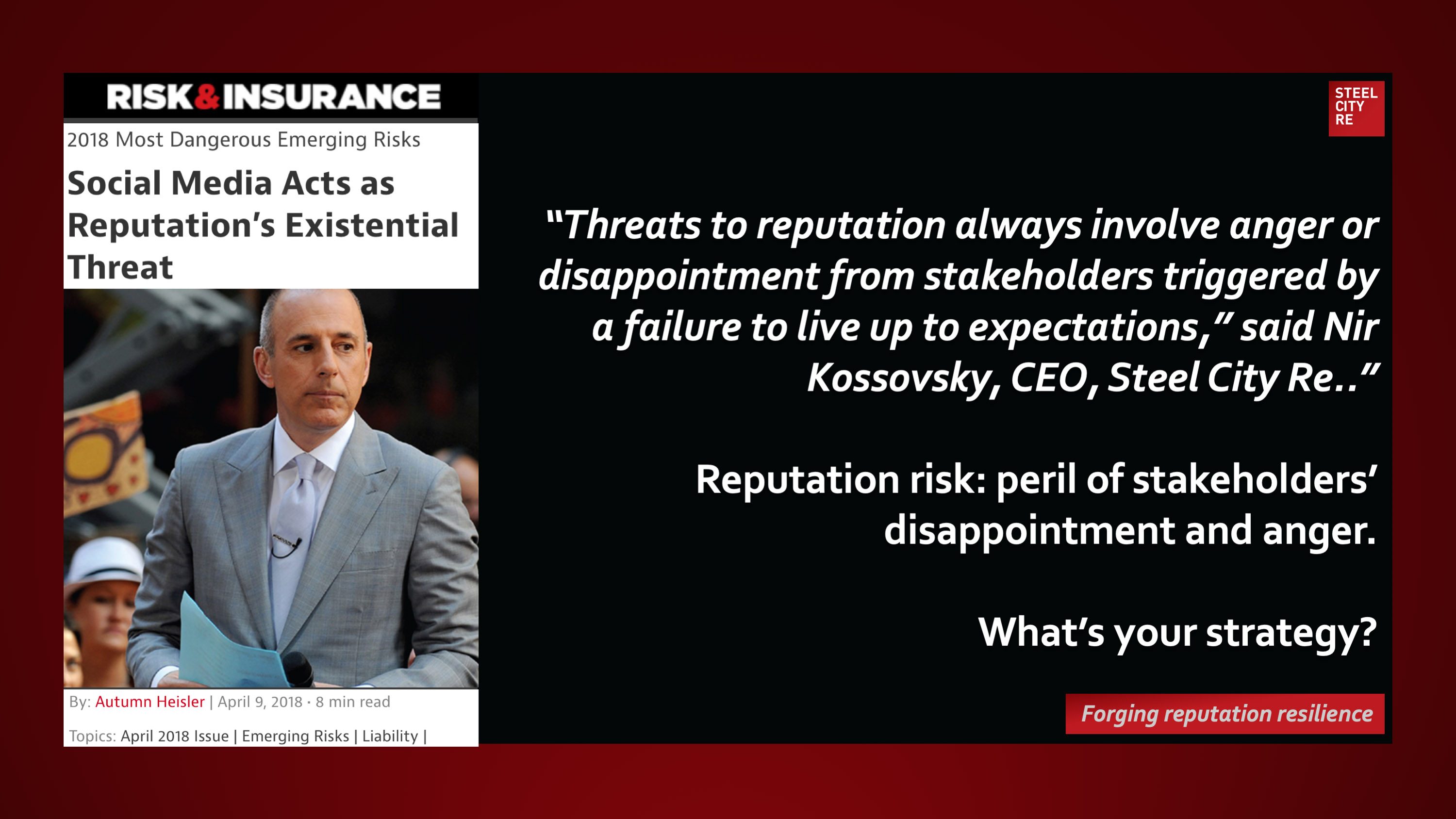Reputation risk isn’t new. But the way a business’s reputation is threatened has entered a new realm of uncertainty because of how fast information can travel. The #MeToo movement is just one example of how hundreds of thousands of people can band together globally. It acts as a reminder of just how fast a reputation can fall: reputation is now an existential risk.”
“Because of #MeToo and the gymnastics scandals, there is a concern that employment claim values could go up,” said Larry Reback, managing principal and leader, policy response unit, Integro Insurance Brokers, referencing the former USA Gymnastics doctor Larry Nassar, who has been convicted of serial child molestation.
The value of reputation-related claims is on the rise, too.
Stakeholders, he said, expect companies to have systems in place that act as deterrents for bad behavior, like sexual harassment in Weinstein’s case.
“Threats to reputation always involve anger or disappointment from stakeholders triggered by a failure to live up to expectations,” said Nir Kossovsky, CEO, Steel City Re.
April 9, 2018
Risk & Insurance
“Threats to reputation always involve anger or disappointment from stakeholders triggered by a failure to live up to expectations,” said Nir Kossovsky, CEO, Steel City Re..”
Reputation risk: peril of stakeholders’ disappointment and anger.
Reputations are valuable strategic intangible assets. Threats to these assets⏤ enterprise reputation risks, often mislabeled “brand risks” ⏤ need to be managed, and management needs to be overseen through reputation risk governance lest reputational damage or reputational harm result in long-tailed go-forward losses in economic value and/or political power. Because these intangible risks arise from the interplay of stakeholder expectation, experiences, and media amplification, parametric insurances for intangible asset risks, for reputational value, for reputational harm, and for reputation assurance help mitigate risk by telling a simple, convincing and completely credible story of quality reputation governance to stakeholders. This story telling effect is the expressive power of insurance complementing insurance’s better known instrumental power of indemnification.
Reputation value is a strategic power companies use to sell more, faster, and at premium prices; and to obtain labor, vendor services, as well as capital on preferred terms.
Steel City Re mitigates the hazards of ESG (reputation) risk that threaten reputation value. We use parametric reputation insurances, ESG insurances, and risk management advisory services to make our clients reputationally resilient.
Risk management, risk financing in insurance captives, and risk transfer through reputation insurances comprise the constituent elements of a comprehensive Steel City Re reputation risk governance and management solution.
Click on the highlighted text for a broader view of reputation risk case studies and reputation premium; or to explore additional articles by Steel City Re here, mentions of Steel City Re here, and comments on newsworthy topics by Steel City Re here.
Learn about our services here.
Context and Background
Risk managers are now central to the process for managing risks to reputation and that’s a process marketers and communications professionals need to be a part of. The oversight of reputation risk management is mission-critical.
Courts have increasingly been ruling that reputation is a mission critical function and oversight of its management is a responsibility of the board of directors. Courts are also ruling that marketing statements companies make – if they related to issues that affect their reputation, like ESG – may be considered material by investors. Litigation along these lines has yielded large settlements or verdicts for plaintiffs.
And now, the SEC has proposed new rules requiring disclosures by public companies related to their ESG activities; those statements could become a communications and reputational minefield.
As a result, reputation risk management is evolving into an intelligence gathering operation spanning the entire enterprise, roping in the enterprise risk manager, compliance counsel, and increasingly, reporting up to the Chief Legal Officer. There is a growing recognition that reputation is not a product merely of marketing and media coverage, but of the degree to which stakeholders’ expectations are aligned with actual performance. The reputation risk management process requires a thorough and ongoing analysis of stakeholder expectations, the risks of disappointment, and a plan for either managing those expectations or assessing and insuring against the cost of failure.
One Last Question
Are ESG insurance or reputation insurance part of your strategy?

